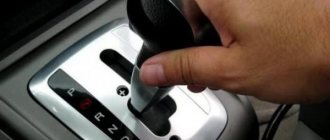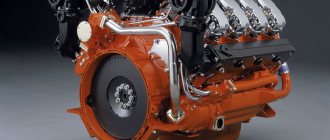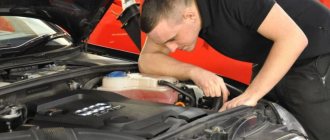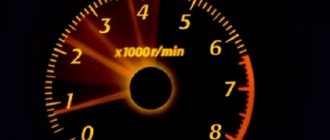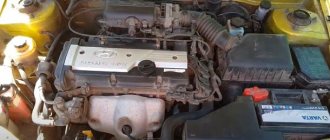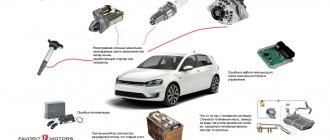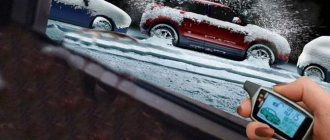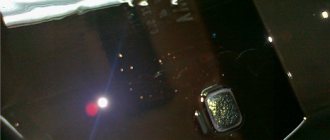Quite often, while operating a car with different types of gearboxes (both manual and automatic), the driver may notice the appearance of jerks in first gear, as well as in second. At the same time, in other gears the indicated jerks may be absent. There are also a number of cases where the problem is of a “floating” nature. In such a situation, jerks appear “cold” and/or “hot”, etc.
Let us immediately note that there are several reasons for the appearance of such a malfunction, starting with the engine power system and ending with the transmission itself. In this article, we will focus on the gearbox, and also look at why the car jerks in first gear, why jerks occur in second gear, and what to look for when diagnosing problems.
Incorrect use of the car's clutch
Beginners do not immediately learn how to smoothly depress the clutch, and when released abruptly, the car begins to drive jerkily. In this case, regular driving practice will help, when the car enthusiast can press both pedals at the same time.
It is important to correctly determine when the mechanism is triggered. As a training technique, use the following technique - set the car in motion without adding gas, gently pressing the clutch. This method is only suitable for machines with mechanical gearboxes.
Automatic vehicles have no clutch at all. Therefore, smooth driving is achieved by gently squeezing the accelerator.
Driving style
You need to start with the obvious things. If you are an experienced driver, then you yourself understand perfectly well that the car can jerk when starting from a stop if the clutch grabs suddenly.
That is, if you release the clutch pedal sharply, then it is quite obvious that the car should move jerkily. In this case there is no malfunction, and this situation is quite normal. All you need to do is change your riding style. At a minimum, you need to release the clutch smoothly and add more gas. It will come with time.
In order for the clutch discs to engage on time, you need to “feel” for the moment of engagement in your car. To do this, you need to engage first gear and try to move away without pressing the gas pedal. This way you can easily feel the moment the clutch discs engage.
This cannot happen in cars with automatic transmissions, because there is no clutch pedal. In such cars, you just need to smoothly press the gas pedal and not “rip” the car from its place.
Diagnostics of CV joints
In all cars with front-wheel drive, the pressure of the gearbox on the wheels is produced using CV joint elements. Even with a slight malfunction of these parts, the vehicle will drive jerkily.
Technical signals of malfunction in CV joints:
- Presence of steering or wheel clearance;
- Tapping while driving a vehicle;
- Sharp squeaking noise when cornering.
These parts are replaced at a service station, however, with proper preparation, doing this yourself will not be difficult. For self-repair, you will need the engine compartment and a set of standard tools.
Dismantling is carried out with the alternate removal of parts from the axle shaft, and the further installation of CV joint parts using a hammer. If the driver has enough repair experience, the whole process takes no more than 1 hour.
Transmission malfunction
The second possible reason is the checkpoint. But if the gearbox is not completely working, then you can also observe other manifestations besides jerks at the start: difficulty shifting any gear, noise from the unit, etc.
If we are talking about a manual transmission, then repairing it can be inexpensive. It is difficult to replace any gear in such a mechanism, but it is possible, and this is something that specialists at service stations undertake. If the automatic transmission malfunctions, the situation becomes more complicated. Repairing it will be expensive. If the variator in an automatic transmission begins to jerk, then the service station most often offers its complete replacement, since repair in this case is impractical.
It is difficult to diagnose a problem due to which a VAZ car jerks when starting off. This can only be revealed by service station specialists during a detailed inspection of the car and its components.
Diagnostics of the engine fuel system
The engine fuel system is a very complex mechanism, consisting of several independent compartments that function harmoniously and a breakdown in one segment entails movement disturbances.
The “symptoms” of problems in this system are as follows:
- The vehicle jerks after quickly pressing the accelerator. The engine starts slowly and the vehicle moves jerkily. There are, of course, cases that while driving, the engine’s operation “levels out” and the car begins to move smoothly, but this is temporary - after each stop the situation will be repeated until a more serious breakdown occurs.
- Also, a malfunction may appear completely unexpectedly. The car may start to jerk when driving evenly somewhere in the middle of the journey.
Situations can be varied and chaotic engine operation can manifest itself both with rapid pressure on the accelerator and with careful (normal) movement. Sometimes, the basis for jerky driving is a lack of fuel in the fuel tank. As a rule, this becomes noticeable immediately after starting the engine.
In addition to the lack of fuel, there may be breakdowns in other parts of the power system.
Checking the fuel filter
Even if the driver fills the car with the highest quality fuel, this does not in any way protect against common blockages. The presence of dirt and foreign objects in the engine power system makes it difficult to move or start the engine.
The problem can be solved quickly - you need to periodically clean the filters from any contaminants, and sometimes change them.
- As a rule, the 3rd filter installed near the gasoline siphon is the most frequently polluted.
- Less commonly, the problem concerns filter 2, located in the middle between the pump and the gas tank.
- After cleaning all the filter elements, be sure to wipe the mesh located near the radiator.
Throttle check
Failure of chokes can be caused by both normal contamination and the degree of depreciation of important elements. In the second case, you need the help of a car mechanic, because... It is necessary to dismantle the failed elements with complete disassembly of the carburetor.
If the problem arose due to dirt, then you can solve it yourself; you will need to wipe the entire surface of the throttle with a cotton rag and a cleaning agent.
Checking the fuel pump
If the problem is in the fuel pump, you will need to contact technical service. In mild cases, a jerky ride occurs due to the formation of a compacted bandage near the bolt.
- The problem is solved by dismantling the failed shutter and diaphragm.
- The main thing is not to forget to seal all gateways and wires through which fuel leakage may occur.
- It is also advisable to additionally wipe the mesh installed near the benzosiphon.
- For injection engines, fuel pumps should be looked for directly in the tank, because they are electrically driven.
After repairs, be sure to check for fuel leaks in the fuel pump. If everything is fine, then the repair can be considered complete.
Fuel quality
Sometimes the problem is in the fuel itself, especially if the driver notices the car jerking immediately after refueling.
- To avoid this problem, it is recommended to use the services of trusted gas stations and strictly adhere to the manufacturer’s recommendations for the type of fuel.
- The fact is that fuel differs in octane number and the method of obtaining fuel.
- Therefore, it is important to read the instructions for using fuel mixtures.
If the driver realizes that the problem is with the quality of the fuel, then it needs to be quickly drained and refilled with another type of fuel.
Checking the sensors
Since modern vehicles contain a huge amount of electronics, we should not forget about sensors. A standard short circuit can disrupt the ignition process or fuel supply to the engine. Auto electricians solve this problem.
Diagnostics of the clutch system in a car
Don't forget about the clutch system. Failures in this area are accompanied by increased fuel consumption, problems starting the engine or loss of driving power.
Malfunctions are as follows:
- Mechanical damage or wear of the driven disk. As a rule, it is not repaired, but replaced with a new one.
- Disc hub jamming. It is recommended to clean the hub from dirt, and sometimes replace it.
- Wear of linings. It is recommended to remove the disk.
The disk is replaced in the inspection hole; if desired, the front part of the vehicle can be raised with a jack.
Repair process for replacing a disk:
- First, all external elements that block access to the clutch are removed.
- Remove the clutch cover.
- Remove all parts from the crankshaft.
- Install a new disk.
- Reassemble the device.
The whole process takes about 40 minutes, maximum 1 hour.
Diagnostics of the ignition unit
Uneven driving of the car is sometimes due to insufficient spark or untimely ignition of the fuel.
If you suspect a malfunction in the ignition system, you should check the following:
- Operation of spark plugs. Experienced mechanics can accurately determine the quality of the air-fuel mixture and the overall performance of the system by the color of the carbon deposits. For example, black soot indicates a faulty ignition. When diagnosing a car, you should check for the presence of a gap between the contacts of the spark plugs; if there is one, then you need to adjust this moment. Then check the spark. Ideally, the spark should be strong with a purple or bright blue hue. If the color of the spark is orange or even yellow, then most likely there is a current leak or insufficient operation of the ignition coil. Also, perhaps the spark plugs have already “worked out” and it’s time to replace them.
- High voltage wires. Check faults with a megger. Sometimes you can visually see a current leak, especially in the dark.
- Ignition coils. If there is no spark or it is very weak, then check for an open circuit in both windings. The presence of breaks can be seen visually, but it is recommended to double-check with a multimeter.
There are many situations when the car jerks when moving from a stop and there are no exact proven recommendations for eliminating this malfunction. In order to repair a car, a detailed diagnosis of all vehicle systems will be required.
Problems with other elements
Quite often, Opel cars jerk when starting from a stop due to problems with the exhaust gas recirculation valve. This valve is a headache for many Opel owners with Ecotec engines. As a result of the formation of soot on the valve, it may simply become clogged, and then an incomprehensible mixture consisting of fuel, air and waste exhaust gases will enter the combustion chambers. This is fraught with loss of power, increased consumption and, possibly, jerks at start.
Therefore, it is very important to fill only high-quality gasoline, and not save on buying fuel suitable for your engine. The same can be said about oil. Under no circumstances should you fill in oil with the wrong viscosity or additives!

